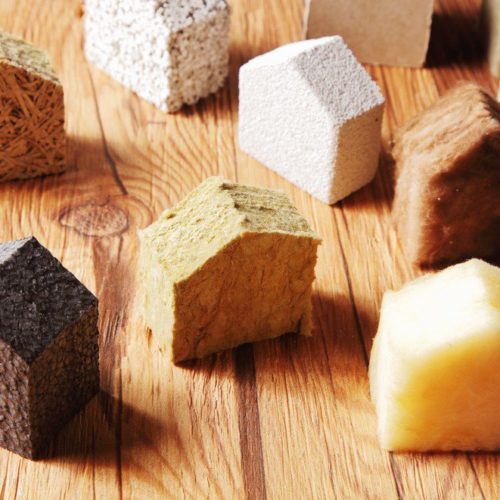At the latest since the energy transition, every prospective builder has probably thought about ways of thermal insulation in their own home. Even with houses that are already finished, it may be worth retrofitting again. In short: Everyone benefits from the correct handling of insulating materials. Here we tell you what you should know about insulating materials.
the essentials in brief
- If you insulate your house properly, you save on heating costs and often do the environment a favor by using less energy.
- The most common insulation materials are EPS and XPS, but biological insulation materials such as hemp, cellulose or cork can be good alternatives.
- There is no “best” insulating material. You should carefully weigh the pros and cons of each material, while also considering the location and condition of your home.
EPS and XPS at a glance
When it comes to insulation when planning a new home, few people are likely to be enthusiastic – but wrongly so! It is true that insulating materials in a finished house are much more difficult to show visitors than a carport or a terrace, but a look at the electricity bill at the latest shows which secret superpower is hidden between the walls. EPS or XPS are usually responsible for the savings, because they are the most common insulating materials.
EPS
EPS (Styrofoam) at a glance
Price: 7-15€/m²
Thermal conductivity: approx. 0.03 to 0.05 W/(m K)
EPS, short for expanded polystyrene and most probably better known by the brand name Styropor , is one of the cheapest insulating materials at €7-15/m² and is therefore very popular with many builders. A big advantage is the simple attachment, which saves installation time and thus costs and can also be done by laypeople. However, if you lend a hand yourself, you should be careful: if you make mistakes in the installation, the insulating capacity can deteriorate and the risk of mold can increase.
However, if installed properly, there is no need to worry about your health. This also applies to the composition of EPS: With the exception of the fire retardant HBCD, which used to be often applied to EPS mats but is no longer allowed to be used in new construction projects, the insulating material usually does not contain any toxic substances. Even without HBCD, EPS is very difficult to ignite, but if a fire does break out, it is also difficult to extinguish. Since the individual insulation mats are also connected to one another via the facade, it often burns down completely once a mat catches fire. In addition, if EPS is demolished or replaced, it is difficult and therefore expensive to dispose of. Such a replacement can also be imminent faster than with some other materials: EPS usually only lasts 20 to 30 years and quickly becomes brittle when exposed to strong sunlight.
| Benefits of EPS | Disadvantages of EPS |
| attractively priced | difficult to extinguish in case of fire |
| very good thermal insulation | Disposal difficult and expensive |
| easy processing | not very long lasting |
XPS
XPS (Styrodur) at a glance
Price: 15-25€/m²
Thermal conductivity: approx. 0.03 to 0.05 W/(m K)
XPS, short for extruded polystyrene and also known as Styrodur , also has very good insulating properties. In addition, XPS also has the advantage of being moisture and weather resistant and overall more stable than its sister material.
This is because XPS has a homogeneous and closed cell structure, which can be seen from the outside as a uniform foam structure and is colored in pastel shades by most manufacturers.
In comparison, EPS consists of individual particles that many probably know as small, white beads. Due to its dense structure, XPS is able to withstand higher pressures and is also less susceptible to moisture penetration. However, the disadvantages of XPS are similar to those of EPS: In the event of a fire, heavy smoke develops and toxic gases can escape. A fire is difficult to extinguish and often spreads to surrounding insulation mats. If the sun is too strong, the XPS mats also become brittle just as quickly as those made of EPS.
| Benefits of XPS | Disadvantages of XPS |
| quite cheap | in case of fire strong smoke/gases |
| insulates very well | not UV resistant |
| Moisture and weather resistant | |
| high compressive strength |
Which insulating material should it be – the insulating materials in comparison
EPS vs XPS
Pro XPS: more stable, less sensitive to moisture
Per EPS: cheaper
A common criticism of both of these traditional insulating materials, however, is that the environmental benefits that one hopes to gain from saving heating energy are almost nil when offset against the energy used to manufacture the products. The EPS and XPS insulation mats are made from fossil, i.e. non-renewable raw materials. A good alternative for environmentally conscious builders can therefore also be ecological insulating materials : cellulose, for example, is an ecologically responsible substitute for EPS, since the insulating properties of both materials are similar, but the use of cellulose pollutes the environment less than that of EPS.
However, it is not possible to say in general which insulating material you should choose. Rather, it is worth weighing up the advantages and disadvantages individually and depending on the nature and location of the house and your budget in order to make an informed decision.



